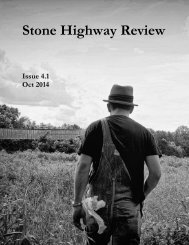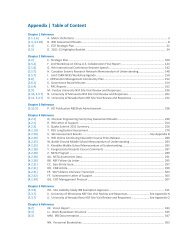ICAME Journal No. 34Given the choices made by the editors, the Brown corpus provides us with apoor tool to examine how the language of these two text portions differ.12. A more careful and extensive account of <strong>Fries</strong>’s work on the EMED can befound in Bailey (1985a).13. <strong>Fries</strong> (1945: 55–56) also addresses the issue of lexical sets although withoutusing that term.14. xghwylc prn. indef. ‘each’, ymbsittendra gen. pl. ‘neighbouring people’.The construction means 'each of the neighbours'. Of course the post-positivegenitive construction cannot be illustrated using Modern English sinceit has gone out of use. Michael Cummings provided this example from OE.15. The particular data summarized in Table 4 do not support the 100 year timelinementioned in this quotation; however most of the other changes that hestudied were accomplished in the roughly 100 year period mentioned here.In addition to the 100 year timeline for individual changes, he also notedthat many of the individual changes seemed to achieve the same sort of end(e.g. the reduction of the inflectional endings) in different parts of the language.He used the term ‘slope’ to describe these sets of related changes.16. It is useful to notice that he was not simply addressing dialect differenceshere, nor ‘dialect mixture’.17. An interesting feature of this example is that, technically speaking, only thelast data sample, from 1300, actually illustrates a true two-term system. Allthe others contain evidence of a third option. But in four of the five sampleperiods the third option (whichever it is) accounts at most for 1.2 percent ofthe data, and so it is reasonable to treat these systems as two term systems.The only exception is the data set from 1200, where the two options usedleast frequently are 11.8 percent and 6.3 percent compared to the dominantoption that is used 81.9 percent.18. Notice that my discussion here largely ignores the difference in forminvolved in the evolving system. The issue is that there is, in some stratum,a system which has two terms, the realizations of the terms may differ astime passes but the system itself is relatively steady.19. See Sinclair and Mauranen (2006) for a recent account of a principled wayto address some of the dysfluencies mentioned above.20. One corpus gathered by <strong>Fries</strong> has been omitted from this table. At about thetime when he was completing his American English grammar, <strong>Fries</strong>became interested in exploring variation in grammar that correlated withgeographical dialects. He purchased a number of local newspapers fromaround the United States published in a particular week. Unfortunately hefound that the stories printed in those papers contained few regionalisms.As a result he abandoned that project.116
Charles C. <strong>Fries</strong>, linguistics and corpus linguisticsReferencesBailey, Richard W. 1985a. Charles C. <strong>Fries</strong> and the Early Modern English dictionary.In P. H. <strong>Fries</strong> and N. M. <strong>Fries</strong> (eds.), 171–204.Bailey, Richard W. 1985b. Charles C. <strong>Fries</strong>: The life of a linguist. In P. H. <strong>Fries</strong>and N. M. <strong>Fries</strong> (eds.). 1985: 1–15.Biber, Douglas. 1988. Variation across speech and writing. Cambridge: CambridgeUniversity Press.Biber, Douglas, Susan Conrad and Randi Reppen. 1998. Corpus linguistics:Investigating language structure and use. Cambridge: Cambridge UniversityPress.Chomsky, Noam. 1957. Syntactic structures. The Hague: Mouton.Chomsky, Noam. 1962. A transformational approach to syntax. In A. A. Hill(ed.). Third Texas conference on problems of linguistic analysis in English,124–169. Austin, TX: The University of Texas.<strong>Fries</strong>, Charles C. 1925. The periphrastic future with shall and will in ModernEnglish. PMLA 40 (4): 963–1024.<strong>Fries</strong>, Charles C. James Holly Hanford, and Harrison Ross Steeves. 1926. Theteaching of literature. New York: Silver Burdett and Co.<strong>Fries</strong>, Charles C. 1927. The teaching of the English language. New York: ThomasNelson & Sons.<strong>Fries</strong>, Charles C. 1940a. American English grammar. New York: Appleton CenturyCrofts.<strong>Fries</strong>, Charles C. 1940b. English word lists: A study of their adaptability forinstruction. Washington, DC: American Council on Education.<strong>Fries</strong>, Charles C. 1940c. On the development of the structural use of word-orderin Modern English. Language 16 (3): 199–208.<strong>Fries</strong>, Charles C. 1944a. Letter to Albert Marckwardt. April 26, 1944.<strong>Fries</strong>, Charles C. 1944b. Letter to Dean Clarence S. Yoakum. April 20, 1944.<strong>Fries</strong>, Charles C. 1945. Teaching and learning English as a foreign language.Ann Arbor, Michigan: University of Michigan Press.<strong>Fries</strong>, Charles C. 1952. The structure of English. New York: Harcourt Brace.<strong>Fries</strong>, Charles C. 1954. Meaning and linguistic analysis. Language 30: 57–68.<strong>Fries</strong>, Charles C. 1959. Letter to Peter H. <strong>Fries</strong>, November 15, 1959.<strong>Fries</strong>, Charles C. and Agnes C. <strong>Fries</strong>. 1961. Foundations for English teaching.Tokyo, Japan: Kenkyusha Ltd.117
- Page 1 and 2: Charles C. Fries, linguistics and c
- Page 3 and 4: Charles C. Fries, linguistics and c
- Page 7 and 8: Charles C. Fries, linguistics and c
- Page 9 and 10: Charles C. Fries, linguistics and c
- Page 11 and 12: Charles C. Fries, linguistics and c
- Page 13 and 14: Charles C. Fries, linguistics and c
- Page 15 and 16: Charles C. Fries, linguistics and c
- Page 17 and 18: Charles C. Fries, linguistics and c
- Page 19 and 20: Charles C. Fries, linguistics and c
- Page 21 and 22: Charles C. Fries, linguistics and c
- Page 23 and 24: Charles C. Fries, linguistics and c
- Page 25 and 26: Charles C. Fries, linguistics and c
- Page 27: Charles C. Fries, linguistics and c
- Page 31: Charles C. Fries, linguistics and c








